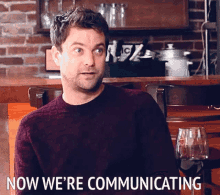I. Introduction
By now, you know that media buyers and ad experts play a crucial role in scaling businesses and driving growth. However, the success of these partnerships isn’t guaranteed by simply hiring the most expensive or renowned professional in the field and dumping a whole bunch of cash into running ads.
You need a strategic approach, clear communication, and a solid foundation to really make thinks work.
When it’s all said and done, there are five key strategies that can help you maximize growth when working with media buyers and ad experts. I’m gonna reveal them to you. These lessons are drawn from our own extensive experience in managing successful advertising campaigns for a diverse range of clients, from startups to established brands like Athletic Greens, Publishing.com, and Consulting.com.
We’ll explore why your product is the cornerstone of any successful ad campaign, and why even the most skilled media buyer can’t compensate for a subpar offering. We’ll discuss the importance of understanding your specific needs before hiring, and how to clearly define responsibilities to avoid confusion and inefficiency.
Furthermore, we’ll delve into the critical role of communication and expectation setting in these partnerships. You’ll learn how to establish clear goals, align your media buyer with your overall business strategy, and set up effective feedback loops.
Lastly, we’ll explore the power of data-driven growth strategies and how to implement them effectively. You’ll understand why measuring performance is crucial and how to use these insights to continuously optimize your campaigns.
By the end of this article, you’ll have a comprehensive understanding of how to position your media buying partnerships for success. Whether you’re considering hiring a media buyer for the first time or looking to optimize your existing relationships, these strategies will provide you with a roadmap for maximizing growth and achieving your advertising goals.
II. Your Product is the Foundation
The first and most crucial lesson in maximizing growth with media buyers is understanding that your ads are only as good as your product. This principle is often overlooked, but it’s the bedrock of any successful advertising campaign.
If you’re working with an unproven offer or what Gary Halbert colorfully termed a “sh*t sandwich,” your ads are unlikely to perform well, regardless of who’s managing them. Even the world’s best media buyer can’t overcome fundamental flaws in your product or its market fit.
Think of it this way: you could hire Michael Schumacher for a Formula 1 race but if you give him a slow car or a broken car, he won’t be able to win ANY race and perform at his best. Similarly, a media buyer needs a solid product to work with to deliver results.

This concept extends beyond just media buying. In sales, even the most charismatic and skilled representatives can’t consistently sell a product that doesn’t meet customer needs or expectations. The product itself must have inherent value and appeal to the target market.
It’s crucial to remember that media buyers are not magicians who can wave a wand and magically fix and scale your business. Their role is to optimize and scale what is already working. They can amplify success, but they can’t create it out of thin air.
Before you even consider hiring a media buyer, ensure that you have a proven offer. Test your product in the market, gather customer feedback, and refine your offering. Once you have evidence that your product resonates with your target audience and solves a real problem, then you’re in a position to leverage a media buyer’s expertise effectively.
Remember, investing in advertising before your product is ready is like pouring water into a leaky bucket. Fix the product first, then amplify its success with strategic media buying.
III. Identify Your Specific Needs
Before you start your search for a media buyer, it’s crucial to understand exactly what you need. Hiring someone to run your ads without a clear understanding of your requirements is a surefire way to waste money and time.
Start by asking yourself some key questions:
- Do you actually need a full-time media buyer, or could you benefit more from one-on-one advice from an expert in your industry?
- Are you looking for help with overall strategy, or do you just need someone to execute a strategy you’ve already developed?
- What’s your budget? Which traffic sources are you targeting? What are your key performance indicators (KPIs)?
- How do you plan to compensate the media buyer? Are you open to performance-based pay or profit sharing?
- Do you expect the media buyer to assist with creatives, copy, and funnels, or will these be handled internally?
These questions will help you create a clear job description and set realistic expectations. For instance, if you’re a startup with a limited budget, you might need a jack-of-all-trades who can handle strategy, execution, and even some creative work. On the other hand, if you’re an established company with an in-house marketing team, you might be looking for a specialist to optimize your existing campaigns.
Understanding your budget and preferred traffic sources is also crucial. Some media buyers specialize in specific platforms like Facebook or Google Ads, while others have broader experience across multiple channels.
Your compensation structure can also impact the type of media buyer you attract. Performance-based pay might attract more experienced professionals willing to bet on their skills, while a fixed salary might be more appropriate for less experienced buyers or more stable, long-term arrangements.
By clearly identifying your needs upfront, you’ll be better positioned to find a media buyer who can truly drive growth for your business. This clarity will also help you avoid misalignments and disappointments down the line.

IV. Clearly Define Responsibilities
One of the most common pitfalls in media buyer engagements is a lack of clarity regarding roles and responsibilities. To avoid this, it’s crucial to get super clear on what tasks the media buyer will handle versus what will be managed internally.
Here are some key areas to consider:
- Ad Management: Who will be responsible for launching campaigns, optimizing them, and making day-to-day adjustments?
- Creative Concepts: Who will generate ideas for new ad creatives?
- Copywriting: Who will write the ad copy?
- Content Creation: Who will produce the visual content for ads?
- Landing Pages and Funnels: Who will build and optimize these crucial conversion elements?
- Reporting: Who will monitor and report on account metrics? What about broader business metrics?
It’s important to note that traditionally, a media buyer’s primary role is to manage ad campaigns. They’re not necessarily copywriters, funnel builders, or creative directors. However, the most skilled media buyers in the industry often have capabilities that extend beyond just running ads.
That said, finding a truly full-stack media buyer who excels in all these areas can be challenging. They’re in high demand and can be difficult to secure. This is why we’re building a pre-vetted marketplace of top-tier media buyers at MediaBuyer.com, to make this talent more accessible.
When defining responsibilities, be as specific as possible. For example, if the media buyer is responsible for reporting, specify which metrics they should track, how often they should report, and in what format.
Clear delineation of responsibilities serves several purposes. It ensures that all necessary tasks are covered, prevents duplication of efforts, and sets clear expectations for both parties. It also provides a framework for evaluating performance and addressing any issues that may arise.
Remember, the goal is to create a symbiotic relationship where both your internal team and the media buyer can focus on their strengths and work together efficiently towards your growth goals.

V. Establish Clear Communication and Expectations
When we observed the most successful media buying engagements at MediaBuyer.com, one factor consistently stood out: clear communication and well-defined expectations. This is where you position the media buyer for peak performance and set them up for success.
First, establish a robust method of communication. This could be regular video calls, a dedicated Slack channel, or whatever works best for your team. The key is to ensure that information flows freely and quickly between you and your media buyer. Set up regular performance check-ins – weekly or bi-weekly meetings can help keep everyone aligned and address any issues promptly.
Next, clearly define your goals. What specific metrics are you aiming for? Common key performance indicators (KPIs) include Cost Per Acquisition (CPA) and Return on Ad Spend (ROAS). Make sure these goals are SMART: Specific, Measurable, Achievable, Relevant, and Time-bound.
Role expectations should also be crystal clear. This ties back to the previous point about defining responsibilities. Everyone should know exactly what’s expected of them and by when.
Compensation terms should be unambiguous. Whether you’re offering a fixed salary, performance-based bonuses, or a profit-sharing arrangement, make sure all parties understand and agree to the terms.
Perhaps most importantly, ensure that your media buyer understands your overall business strategy and how the advertising efforts fit into it. They should be aware of your brand voice, target audience, and long-term goals. This alignment helps the media buyer make decisions that not only improve ad performance but also contribute to your broader business objectives.

By setting these “guardrails for growth,” you create an environment where your media buyer can thrive. Clear communication and expectations reduce misunderstandings, align efforts, and ultimately drive better results. Remember, your media buyer is a partner in your growth journey – treat them as such, and you’ll be more likely to achieve the success you’re aiming for.
VI. Implement Data-Driven Growth Strategies
When it comes to ads, data is king. To maximize growth with your media buyer, it’s crucial to implement data-driven strategies and create effective feedback loops. Remember, in order to grow, you must first measure.
Start by tracking and regularly reviewing key metrics. These might include conversion rates, cost per acquisition (CPA), return on ad spend (ROAS), click-through rates (CTR), and more. The specific metrics you focus on will depend on your business goals and the nature of your campaigns.
Use this data to understand what’s working and what’s not. Are certain ad creatives performing better than others? Is one audience segment converting at a higher rate? Is there a particular time of day when your ads are most effective? These insights can guide your optimization efforts.
Establish a feedback loop with your media buyer to review and discuss these insights. Regular check-ins (as discussed in the previous section) provide an opportunity to analyze the data together and make real-time adjustments to your campaigns.
It’s not enough to just collect data – you need to take action based on these insights. This might involve tweaking ad copy, adjusting targeting parameters, reallocating budget, or even revisiting your overall strategy. The key is to be agile and responsive to what the data is telling you.
Remember that optimization is an ongoing process. What works today might not work tomorrow, so continual testing and refinement are crucial. Encourage your media buyer to run controlled experiments, testing new ideas against proven performers to drive continuous improvement.

Lastly, don’t just focus on ad metrics in isolation. Look at how they tie into broader business goals. Are improvements in ad performance translating to increased revenue or customer lifetime value? This holistic view can help ensure that your advertising efforts are truly driving business growth.
By implementing these data-driven strategies and feedback loops, you dramatically increase the likelihood of sustained growth. It’s about creating systems that ensure you’re consistently improving and getting closer to your goals with every optimization and iteration.
VII. Conclusion
Maximizing growth with media buyers and ad experts is not about finding a magic bullet or a one-size-fits-all solution. Instead, it’s about creating the right conditions for success through strategic planning, clear communication, and data-driven decision-making.
We’ve explored five key strategies that can help you achieve this:
- Recognizing that your product is the foundation of any successful ad campaign. Even the best media buyer can’t compensate for a subpar offering.
- Identifying your specific needs before hiring, ensuring you bring on the right expertise for your unique situation.
- Clearly defining responsibilities to avoid confusion and ensure all aspects of your advertising efforts are covered.
- Establishing clear communication channels and expectations, aligning your media buyer with your overall business strategy.
- Implementing data-driven growth strategies and feedback loops to continuously optimize your campaigns.
By applying these strategies, you set the stage for a productive and growth-oriented relationship with your media buyer. You create an environment where they can leverage their expertise effectively, driving real results for your business.
Remember, these aren’t just theoretical concepts. These are tried and tested strategies that my team and I apply every day for companies like Athletic Greens, Publishing.com, Consulting.com, Joe Zieja, Caitlin Bacher, and many other established brands. We’ve seen firsthand how these approaches can dramatically increase the likelihood of sustained growth.
As you move forward with your advertising efforts, whether you’re working with an in-house team or external experts, keep these principles in mind. They’ll help you navigate the complex world of digital advertising, make the most of your ad spend, and ultimately drive the growth you’re aiming for.
If you’re thinking about bringing on a media buyer or investing more into ads, you need to heed this universal truth: having a solid framework FIRST for working with media buyers and ad experts is essential for success. Apply these strategies, and you’ll be well on your way to maximizing your growth potential.
Click HERE to apply to join Mediabuyer.com today to browse our marketplace and discover the perfect media buyer for your business.

